Phone: 03 577 2395
C/- Marlborough Research Centre Trust, PO Box 875, Blenheim 7201


Eucalyptus globoidea (White stringybark) is a species which grows well across a range of sites, and produces Class 2 durable timber which is heavy, versatile and attractive. E. globoidea has good natural form and self-pruning ability. It is the first NZDFI species for which a growth model has been produced.
The first generation of XyloGene-branded improved E. globoidea seed and seedlings produced by NZDFI's breeding programme are available for growers to purchase. Visit our XyloGene pages for more information.
Matching eucalypt species to site is essential for good tree survival and growth. E. globoidea is a versatile species, and can already be found growing well in a range of New Zealand locations. Watch our video below, make sure you know your proposed planting site, then ideally talk to an experienced grower or nurseryman before purchasing trees.
Follow our establishment guidelines for good establishment success.
E. globoidea may occasionally require form pruning, especially if unimproved stock is planted. Little clearwood pruning should be necessary if growing post and pole wood. For high quality sawlogs, some clearwood pruning at an early age may be necessary, but again this is less likely if improved XyloGene planting stock is used.
Read our form-pruning guidelines and watch some videos.
E. globoidea suffers less from insect and possum browse than some other eucalypt species.
Summer/autumn flowering but with one winter record (Marlborough). Flowers regularly and yields good quantities of pollen and but not so much nectar. Good flavoured amber honey.
E. globoidea is the NZDFI species for which most growth models have been created.
Research by successful PhD candidate Serajis Selakin led to the development of some early growth models for E. globoidea and E. bosistoana
Hybrid growth models for E. globoidea and E. bosistoana (Salekin 2019)
More advanced modelling work, including modelling of tree taper and heartwood volume, was then completed by PhD candidate Daniel Boczniewicz.
More recently, carbon sequestration has been added to the model by Professor Euan Mason. The most recent version of the model is freely available.
Two NZDFI PhD projects at the School of Forestry have focused on E. globoidea timber properties.
Note: Durability is a complex parameter; NZDFI’s research into heartwood formation will improve our understanding of factors determining durability.
Structural uses, poles and posts, crossarms, railway sleepers, vineyard and fence posts. Also has potential as a flooring and furniture timber.
NZDFI anticipates E.globoidea will be highly suited as a component of high strength engineered wood products such as laminated veneer lumber (LVL) and cross laminated timber (CLT).
Watch this powerpoint presentation about research into E. globoidea's veneer potential.
E. globoidea has a wide natural range through eastern New South Wales except the far north, and eastern Victoria except in areas where summers are too cool. It is found at altitudes of 0-1100 metres.
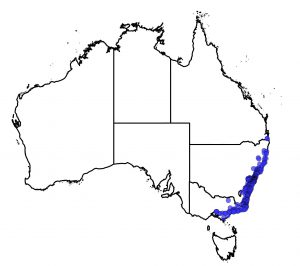
E. globoidea was selected for the NZDFI breeding programme based on its consistent performance across a range of sites.
There is considerable experience with E. globoidea on milder areas in New Zealand, where it has grown well for many decades.
Form is generally good although on fertile sites there may be a propensity to form double leaders.
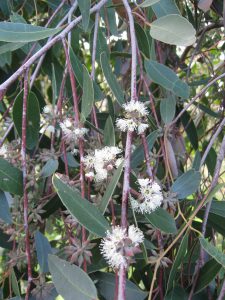
E. globoidea flowers and buds.
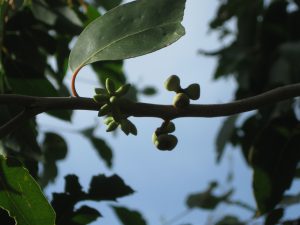
E. globoidea seed capsules and flowering buds.

E. globoidea seed capsules.
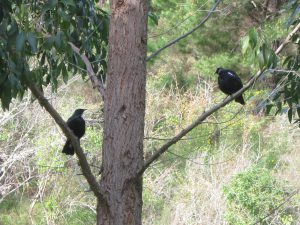
Two tui in young E. globoidea tree.
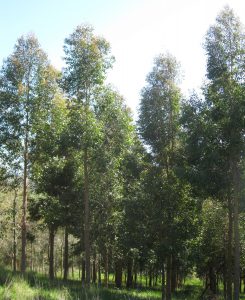
7 yr old E. globoidea in NZDFI trial in Hawkes Bay.
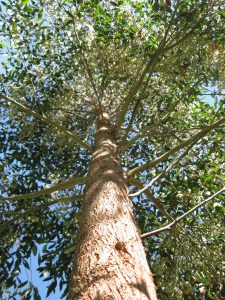
A prolifically flowering E. globoidea.
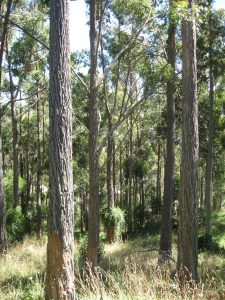
25 year old E globoidea, Banks Peninsula.
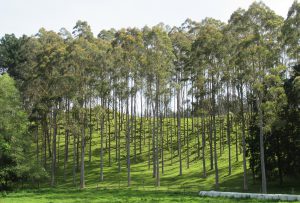
27 yr old E globoidea, Bay of Plenty.
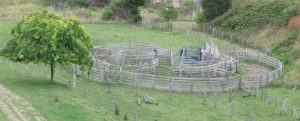
Stock yards built using E globoidea in Gisborne.

E. globoidea posts in use in a vineyard.
E. globoidea performed well in early NZDFI trials (2003-04 plantings) in Marlborough and Canterbury, and was selected as a species on which to focus NZDFI breeding effort from 2008 onwards.
Analysis of E. globoidea's performance in NZDFI's demonstration trial network shows that the species grows exceptionally well on some site types, and well across a range of site types (although performance is variable, as with all NZDFI species). Read our Trial sites adaptability and productivity results for full details.
E globoidea is a leading species in NZDFI’s breeding programme. NZDFI has established over 160 families for intensive genetic improvement. There had been no genetic improvement of this species before the NZDFI programme.
Read more about our breeding programme here.
Seed collection from elite trees within NZDFI's E. globoidea breeding populations is now underway. Some seed is being supplied to nurseries to produce planting stock for growers; second generation trials are also being established.
The first generation of XyloGene-branded improved E. globoidea seed and seedlings produced by NZDFI's breeding programme are available for growers to purchase. Visit our XyloGene pages for more information.
| E. globoidea wood properties | NZ plantation timber | Australian native timber |
| Shrinkage | Tangential 4.5 % | Tangential - N/A |
| Radial 2.6 % | Radial - N/A | |
| Density | 805 kg/m 3 | 880 kg/m 3 |
| Hardness | 6.9 kN | 8.8 kN |
| Bending strength | 132 MPa | 133 MPa |
| Compression strength | 67 MPa | 68 MPa |
C/- Marlborough Research Centre Trust, PO Box 875, Blenheim 7201